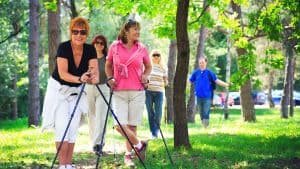
What
comes to mind when you think of aging?
Due to the stereotypes perpetuated by rampant ageism in our society, most of us don’t associate aging with positive images.
Aging Doesn’t Have to Be Negative
As a
physical therapist, my mission is to change the way people think of aging. When
clients come in, initially I only hear about the downsides of aging. The
difficulty with walking. The loss of strength. Chronic pain. And one of the
topics no one wants to talk about – balance issues and falls.
The
first point I want to highlight is that none of the above have to be a normal
part of aging. And if you are experiencing balance problems or falls,
start talking to someone about them right this minute.
With
our aging population, this is an issue that has a major impact on
the health trajectory of the country in multiple ways.
The Real Cost of Not Talking About Falls
In
2015, the costs directly related to fall injuries in older adults totaled over
$31 billion to Medicare alone. That’s right. $31 billion.
And
this does not include costs to other insurance companies or all the secondary
costs that come as a result of falls, including the need for more services and
specialized care or having to move a family member from their home and into a
facility.
Let’s
take a further look at the numbers.
One
out of every four adults over the age of 65 falls each year. Having one
fall doubles the risk of having another. Adults over the age of 75 are the
highest risk group for recurrent head injuries due to repeated falls.
These
are staggering statistics and impact each and every one of us, regardless of
age. As a greater proportion of our population ages, these numbers are expected
to rise. The burden of this preventable problem falls on family members,
younger generations, and our already taxed healthcare system.
What We Can Do About It
First,
we should clarify: falls are not a normal part of aging. Everyone
falls, but excessive falls become a major problem. When you throw other chronic
conditions into the mix, such as diabetes and osteoporosis that increase the risk of severe
injuries with falls, the problem is compounded.
Falls
are not fun to talk about, so they often go unreported to health care
providers. And pride often gets in the way.
They may also go under-reported because there can be some confusion around the definition of a fall. So, to clarify, a fall is defined as any uncontrolled descent. Even if you caught yourself on a chair or a piece of furniture, it’s still a fall. Even if you don’t think you injured yourself, it’s still a fall.
It’s
vital that we begin to talk more about falls and erase the stigma around
talking about falls. Today. Because we can’t solve a problem that isn’t being
talked about.
A Little More About Falls
The
list of risk factors for falls is extensive and includes anything from fear of
falling, to footwear choices, to certain medications.
The
solution to preventing falls is simple in theory, but not so easy to
implement. Staying physically active throughout the lifespan is the first
step in fall prevention. More and better movement is the answer.
However,
this solution puts more responsibility on the person, an active solution rather
than a passive one.
In a
medical system where passive interventions are pushed heavily, including
medication and surgery, it can be difficult to start the conversation on
taking ownership of our health – but that is exactly what’s needed.
So, What Can You Do?
If you have no concerns about falling, get on and off the floor every day as much as possible! Pay more attention to your movement and the variety of your movement. Find ways to challenge your balance every single day.
The
next step is to talk to your loved ones about falls. If you have concerns,
reach out to health care providers for help. Trained movement professionals,
such as physical or occupational therapists, are an essential part of
developing plans to keep people active safely. How can you facilitate this
important conversation today?
What
do you do to prevent falls? Have you experienced a fall in the past? What were
the consequences? Have you discussed the topic with your health care provider?
What was their advice? Please share with our community and let’s have
conversation.
Disclaimer: This article is not intended to provide medical advice. Please consult with your doctor to get specific medical advice for your situation.





